hey! I make homebrew creatures, items, spells and features sometimes! do you like what I'm doing? drop a follow and stay in the loop on future projects! requests are open!
Don't wanna be here? Send us removal request.
Text
I have started uploading my monsters to D&D Beyond, for those who are interested! It’s quite an undertaking and I’ve not made a lot of progress, mostly because there is a ton of backlog to do (there are 68 monster-only posts on this blog, not including any monster stat blocks in the adventures I’ve written!). But there are a couple on there at the moment, and I’m hoping to put in some effort the next few days to get them all uploaded.
Here’s a link to the list of monsters that I’ve uploaded so far.
My username on D&D Beyond is dinraal_ (with the underscore), so if you see any uploads of my creatures on there not under that username, that’s not me! Please let me know if you come across this so I can take action.
37 notes
·
View notes
Photo

Creature: Horizon Mongrel
When stars collapse into black holes, not even light can escape the surface. But occasionally, very rarely when there is not a single pair of eyes in the universe even flitting towards the newly birthed black hole, something else can escape. Something that inherits the churning, black darkness and the intense gravity of its birthplace, and speeds away faster from that sinkhole of death than anyone can follow it.
Black holes incarnate. Many people ask questions about the origins of the horizon mongrels, the creatures called after the black boundary of certain death and crushing gravity near an imploded star. Very few people have answers that aren’t an overactive imagination. Where the mongrels really come from, no one is quite certain, but it’s clear that the patch of space that spits them out is darker and emptier than any other.
Flashing nightmares. Mongrels are solitary creatures that seem to be either completely uninterested in their own kind of entirely unaware of them. Rather, a mongrel seeks out places where the flow of spacetime is warped in some way, or even broken. Powerful graviturges often find themselves hunted by a mongrel, which is capable of great destruction should it ever arrive at its unfortunate victim’s doorstep. And as fast as it appears, it is gone - since they are often not much more than a flash of jaws and choking, crushing gravity, leaving nothing behind.
Slowing down time. The mongrels that have been studied seem to live at a faster pace than most creatures, slowing down their internal clock and allowing them to attain lifetimes of aeons. The only true weapon anyone has against a mongrel is to attempt to slow it, forcing it to experience time at a different speed, which seems to draw out some of its few weaknesses. Stopping a mongrel in its tracks entirely, well... it might just kill it.
#dnd#dnd5e#d&d#d&d5e#dungeons and dragon#5th edition dungeons and dragons#d&d homebrew#dev's homebrews#creature stat block#aberrations#cr12
390 notes
·
View notes
Photo
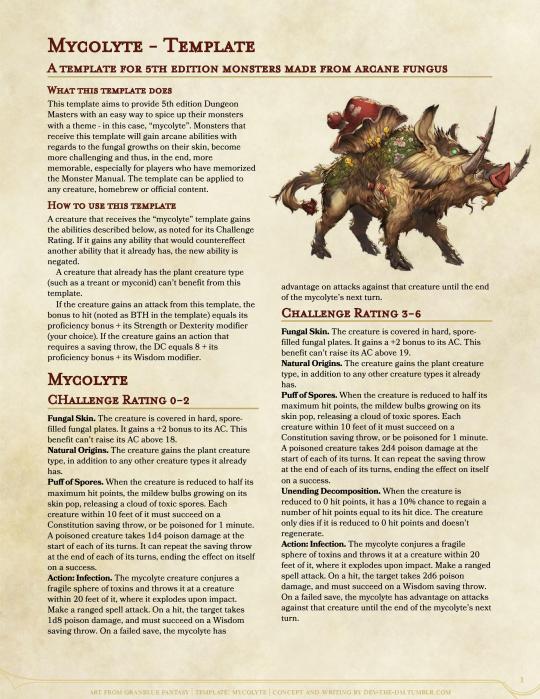
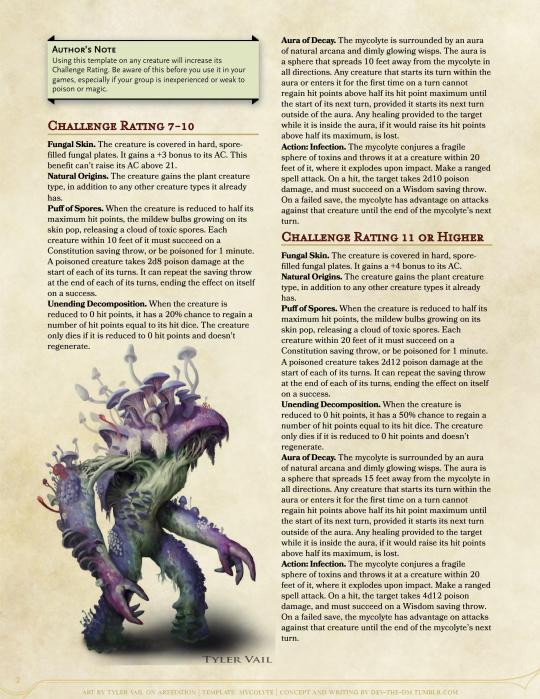
Template: Mycolyte
Some who live in the woods don’t simply enjoy nature as part of their surroundings, but might want to take part in it in a much more literal way. Any who embrace and accept the limitless decay of moulds and fungi that grow on trees may find it can grow on them, too. Their acceptance of the natural cycle of death and life spreads the spores of their philosphy and physical affliction wider - and some believe they are all the more peaceful for it.
This template can be used on any creature of your choice if you want to introduce a fearsome, natural terror or a wise creature of immortal age, always rotting but never dying. It will introduce some deadly powers in your creatures, though, so be wary of any fungal powers that may overwhelm your group!
Do you like this template? I have a few more ideas for other ones, so let me know in the replies of this post or send me an ask and I’ll work on a few more!
For better, full-page high quality imagery, go take a look at the Mycolyte template at the Homebrewery here!
My other templates can be found here.
#dnd#dnd5e#d&d#d&d5e#dungeons and dragons#5th edition dungeons and dragons#d&d homebrew#dev's homebrews#plants#templates#resources#features
146 notes
·
View notes
Note
Porque não tem uma versão da criatura com tradução ?
(Translation using DeepL: "Why don't you have a version of the creature with translation?")
Portuguese below (translated with DeepL, sorry!) // Português abaixo (traduzido com DeepL, desculpe!)
Hi there! I realize English may not be everyone's first language and not everyone may understand and/or speak English well enough to be able to understand the things I post on my blog, but I haven't had any need for translations of my creatures so far, nor have I had any requests for a translation. I'm not sure if I should be offering that, but if necessary, I can offer text-only versions of my creatures (instead of pictures) so you can put them through a translation machine such as DeepL (deepl.com) yourself.
I don't speak Portuguese, nor do I speak any languages besides English and Dutch, so it would be very difficult for me to provide versions of each creature or post in a variety of languages without using machine translations, and they are often not very good. I don't think it'd benefit the blog if I offered that because of the issue with quality. But I'm willing to start adding text-only versions of each post I make, so if your English isn't good enough or you prefer reading it in another language, you can use DeepL or Google Translate yourself to provide that for yourself. Hopefully that answers your question! :)
--
Olá! Sei que o inglês pode não ser a primeira língua de todos e que nem todos podem compreender e/ou falar inglês suficientemente bem para poderem compreender as coisas que publico no meu blog, mas até agora não tive qualquer necessidade de traduções das minhas criaturas, nem tive quaisquer pedidos de tradução. Não tenho a certeza se devo oferecer isso, mas se necessário, posso oferecer versões apenas de texto das minhas criaturas (em vez de fotografias) para que você mesmo as possa colocar através de uma máquina de tradução, como DeepL (deepl.com).
Eu não falo português, nem falo outras línguas para além do inglês e do holandês, por isso seria muito difícil para mim fornecer versões de cada criatura ou correio numa variedade de línguas sem utilizar traduções automáticas, e muitas vezes não são muito boas. Penso que não beneficiaria o blogue se o oferecesse por causa da questão com qualidade. Mas estou disposto a começar a adicionar versões apenas de texto de cada post que faço, por isso, se o seu inglês não for suficientemente bom ou preferir lê-lo noutra língua, pode usar DeepL ou Google Translate você mesmo para fornecer isso para si. Espero que isso responda à sua pergunta!
13 notes
·
View notes
Text
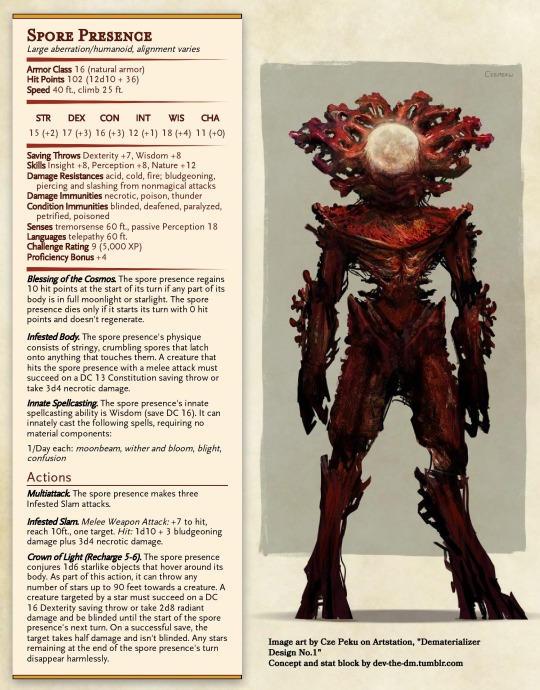
Creature: Spore Presence
"When guardians of nature that have a personal bond with fungi, symbiotic plants and other spore-releasing agents find themselves looking up at the sky and wondering what manner of druidic growths can be found amongst the far reaches of the cosmos, something may reach out to them to help them find it. Something otherworldly, something itself made of spores and infestations. Some choose to turn away from this entity, but others embrace it, moving between the stars, finding their way to distant planes, and returning inherently changed - sometimes for the best, sometimes for worse."
Warped druidic agents. A spore presence was once a druid, human or other, who has departed on a journey of discovery and been touched by something definitively other. They lost their humanity, their appearance, but gained something else in return - considered a blessing by some and a curse by others. In whispered circles, a spore presence's unique form is said to have been caused by the spores of an otherwordly entity, a creature or apparition not quite of this world, which has itself infested the druid's mind and changed it to what it has become.
Solitary patrols. Spore presences tend to find their way back to their homeland after some time, but without the communicative skills they had before their departure. Instead of talking, they use a confusing, disorienting telepathy that consists of warped images and garbled sounds to convey their thoughts and feelings, which only builds fear into the people they attempt to communicate with. Many spore presences that have returned to their home planet instead seek out a solitary life, generally within cave systems or other dark, mouldy locations, where they can merge amongst the fungi and mildew that they themselves have become part of. A spore presence in its hibernation mode - which can last years if it remains undisturbed - merges into the surface on which it rests and becomes a formless, indistinguishable but large patch of spores that emit no sign of life.
Aberrant nature. A spore presence requires no air, food, drink or sleep.
Hybrid nature. A spore presence has two creature types: aberration and humanoid. It can be targeted by any effect if it applies to one of its creature types.
908 notes
·
View notes
Photo

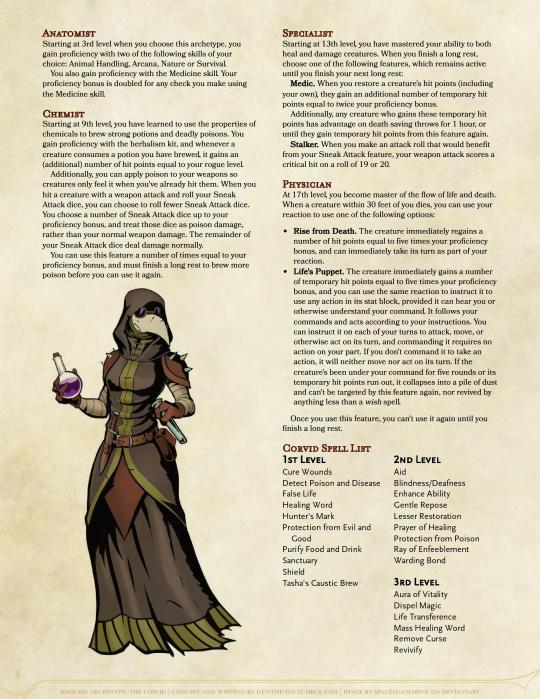
Subclass: The Corvid
Some - but not all - rogues are indeed the murderous, greedy creatures generaly stereotyping make them out to be. But some would rather align themselves with the ebb and flow of life, using their ability to form this energy to their will to heal others or do good. This means they are also able to hit where it hurts, however, making rogues that follow the way of the Corvid doubly dangerous… and doubly useful.
For better, full-page high quality imagery, take a look at the Corvid at the Homebrewery here!
315 notes
·
View notes
Note
Hi, I love your ideas, could you make some monsters of around 10th level that fit in with the whole wildspace setting? I’m not finding any good options myself and I was wondering if you could help.
Hiya! Thanks for the compliment. I was actually going to do this anyway, since I’m a big fan of astronomy and space in general, but I was waiting for the books to come out so I could at least know what sort of guidelines they were going to put down for extraterrestrial monsters :) I’ll definitely create some in the future, though, so keep your eyes open!
- Dev
4 notes
·
View notes
Note
I'm writing a book and found some of your creatures interesting. Is it okay if I create creatures that share certain features as yours? It won't be too similar or like a copy paste where I just change the name, it'll be like a few features and details.
Hiya! This is a difficult question - I’m not sure what kind of book you’re writing, where you’ll publish it and what kind of role my creatures will play in it.
If you’re writing a bestiary, or other 5e/RPG guidebook with stat blocks and such, then my answer is no, don’t use my creatures in your book. Even if you edit them, as the creator I don’t feel comfortable publishing my creatures officially. Commercially, I don’t own the images I use, and I’m very careful with creating any kind of profit off my creatures.
If you’re writing a novel or fanfiction, it becomes a little bit more difficult to determine what’s going to happen. All in all, I would say no if you intend to publish it and/or sell your book. If it’s just for friends and family, I really have no way of knowing if that’s what it’ll be limited to. Give credit where credit is due, of course.
All in all, my creatures and other brews are meant for people to use noncommercially at their D&D table, for their parties to encounter. I don’t create them with the intention of publishing them in any way, as I definitely infringe on Wizards of the Coast copyright and intellectual property.
So, long story short: if you’re going to be publishing anything or making profit off the book, the answer is no. This may sound harsh, but I’d like to be very careful. If you’re writing for yourself and don’t intend on publishing/selling, feel free to take inspiration for my creatures. If you post it online, please credit me.
- Dev
7 notes
·
View notes
Photo
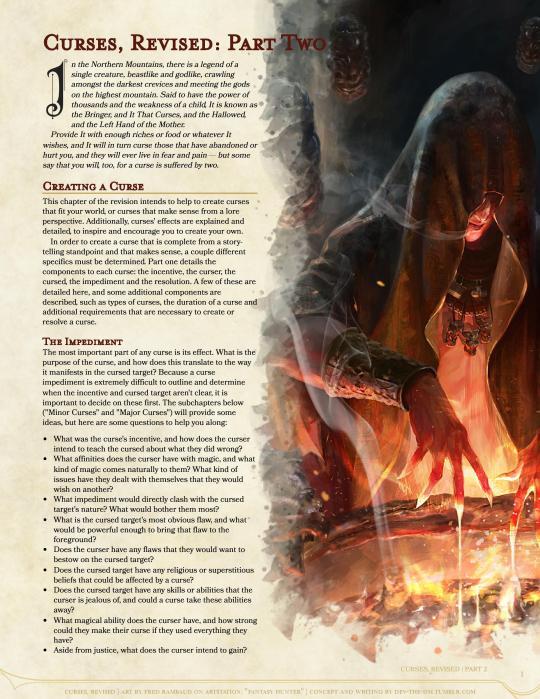
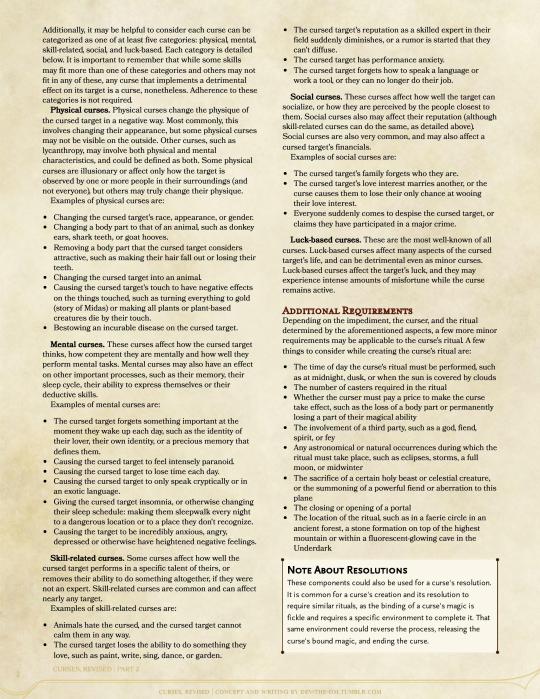

Resource: Curses, Revised: Part Two
Ever felt the official content on curses is too limited by the two spells and handful of rolling tables, and wished for more? Then this is the series for you. I’m working on a multi-chapter revision of curses in D&D 5th edition, which helps you to create and use curses that fit in your setting and that make sense. This is part two of at least three, which are still a work in progress. Keep your eyes peeled for part three :) I will also link it here once it’s posted.
Part one can be found here: Curses, Revised: Part One.
#happy to get this part done and posted!#it's also my birthday today so i had some extra free time to work on it#dnd#dnd5e#d&d#d&d5e#dungeons and dragons#5th edition dungeons and dragons#d&d homebrew#dev's homebrews#collection: curses revised#resources#collections#curses revised#features
208 notes
·
View notes
Note
Would you mind if I used you creatures in my campaign?
Hiya! No, not at all! That's the purpose of this blog :) Feel free to use any of this content in your home games.
If you're streaming your games, or otherwise sharing your game online or with other people, whether commercially or not, please ask before you use my content! However, if you're just playing a home game for you and your players, no need to ask :) All my content is free to use for you!
8 notes
·
View notes
Note
I thought a shardmind would be an elemental in nature, it can use slam and is basically made of rocks, also how do you make the stat blocks?
Hiya there! That fully depends on your definition of construct or elemental. In my lore, shardminds are constructs, since they are created from natural rock formations by strong magic. The magic that infuses them is what gives them their consciousness. Whereas, in my opinion, rock elementals gain their consciousness from the natural materials that they're made of becoming conscious. There's maybe a mild magical influence, especially on the elemental planes, but there is no other entity or consciousness "creating" them as with constructs. But your interpretation is just as valid! If they're elementals in your games, they can be elementals :)
I make the stat blocks using the Homebrewery! I'll append the link here: Homebrewery. I've shared the coding I use for my stat blocks in the past, so if you're interested, you can still find that on my blog :) Happy brewing!
3 notes
·
View notes
Note
Thanks for your time!
The idea is for an an ability for an NPC monster. It’s based on the arcane trickster, but is specifically trained to fight magic users. I’m calling it an arcane hunter, and thinking of making it CR 6-7. However, it could also be a magic item, or a class ability.
For the most part, it’ll have rogue abilities, arcane trickster spellcasting, expertise in arcana and stealth, and two attacks with a rapier.
The ability is called “overcharge spell”: Whenever a spell is cast within 60 feet of the arcane hunter, it can use its reaction to push a bit of extra magic energy into it. This leads to one of four results, based on a d4 roll:
1 - the energy of the spell explodes, the caster and everyone within 5 feet rolls a constitution save. On a failure, take 1d10 force damage per the spell slot of the cast spell. On a success, half damage.
2 - the arcane hunter takes control of the spell energy, directing the spell at whoever they choose, within 20 feet of the caster. (I particularly like this one, because it can be either meaningless or really bad depending on the DM’s timing with the ability).
3 - the spell energy collapses in on itself and has no effect, as if targeted by a counterspell.
4 - the spell functions as normal, but more powerful, as if cast at one spell slot higher.
Recharge on 5-6.
I also asked the blog homebrew-a-la-traumaverse for feedback, and they made the excellent suggestion to have the ability function similar to counterspell. That is, for spells up to 3rd level, the ability functions normally, but for 4th level or higher, the caster of the spell rolls an spellcasting ability check against the arcane hunter’s spell save dc to have their spell function normally. She also suggested I have a successful check makes the spell upcast, but I think I’ll have it only happen if the caster rolls 5 above the spell save dc (which will be 14, I believe).
Hiya! First of all, I'd like to mention that this is a very cool idea and I'm all for it! I definitely think we don't have enough counters to casters in D&D as is (except for counterspell, and maybe confusion effects, which suck for everyone), so I definitely find this a very unique and useful idea.
I like homebrew-a-la-traumaverse's idea of making it similar to counterspell, that fits very well with this idea. However, maybe that makes it a little too similar to counterspell/dispel magic? I definitely think an ability check/saving throw needs to be implemented to make this fair to everyone, though. Instead of making the caster save against the hunter, you could also implement a contested spell ability check, and if the hunter rolls higher than the caster, the hunter's effect takes place.
I'd suggest creating an additional effect on a natural 20 for the hunter (or in case of a contested spell ability check, a natural 1 on the caster's part), like getting to choose one target that the full spell's power is aimed at. It's similar to a roll of 2 on the dice, but I would suggest changing that effect to anyone within 20 feet of the original target, and the natural 20 effect to be anyone within the spell's range, regardless of the original target, if that makes sense. It creates some extra freedom for the hunter to really aim for the PCs who like staying at the back of a fight/out of the way of the other PCs.
Alternatively, you could choose for the hunter to be allowed to pick one of the four effects instead of rolling for it if they roll a natural 20! That has the same effect as above :)
As a fifth and sixth effect, you could implement the following:
5. If the hunter is the target of the spell, it has effect as normal, and the hunter absorbs some of that spell's power. Until the end of the caster's next turn, the hunter has advantage on saving throws to resist the caster's spells (or advantage on all saving throws against spell effects, if you want to beef the hunter up a little).
6. The caster must succeed on a Wisdom saving throw (the DC equals 10 + the spell's level). On a failed save, the caster can't cast that spell again until the end of its next turn.
These are just suggestions! Do with them as you wish, and definitely don't feel obliged to implement any of these suggestions. I hope this was helpful to you :) I'd love to see the finished product, if you're willing to share. Happy brewing!
20 notes
·
View notes
Note
What’s your dad beyond username??I can’t find your official homebrews
Hiya there! I do have a D&D Beyond account, but I currently only use it for playing. I haven't posted any of my homebrews on D&D Beyond, so if you see any of my content there, I didn't post it!
However, if there's a lot of interest in this, I'll consider making it available there too!
- Dev
9 notes
·
View notes
Note
Hey, I had an idea for a cool homebrew thing. Would you mind giving me some feedback on it?
Yes, absolutely! If you'd like to discuss it privately, you can DM me. My inbox is open :) Otherwise, feel free to leave another ask, and other people can pitch in as well!
- Dev
3 notes
·
View notes
Photo
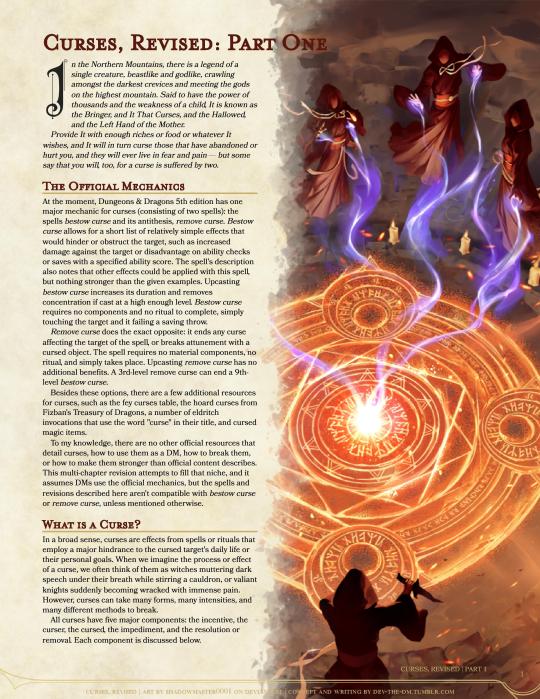


Resource: Curses, Revised: Part One
Ever felt the official content on curses is too limited by the two spells and handful of rolling tables, and wished for more? Then this is the series for you. I’m working on a multi-chapter revision of curses in D&D 5th edition, which helps you to create and use curses that fit in your setting and that make sense. This is part one of at least three, which are still a work in progress. I’m hoping to get these all done soon, so I can post them all in a row, or at least relatively close together. Keep your eyes peeled for part two :) I will also link it here once it’s posted.
Part two can be found here: Curses, Revised: Part Two.
#dnd#dnd5e#d&d#d&d5e#dungeons and dragons#5th edition dungeons and dragons#d&d homebrew#dev's homebrews#collection: curses revised#resources#collections#curses revised#features#??? kind of
272 notes
·
View notes
Photo


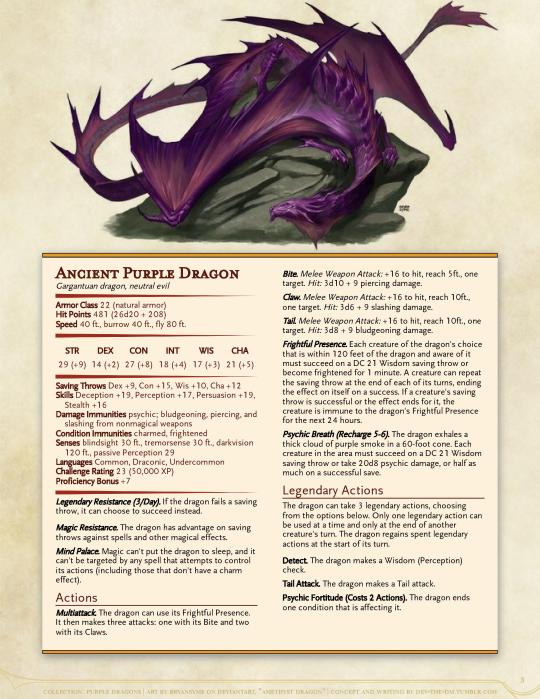
Collection: Purple Dragons
“Born from amaranthine, great form uncoiled, ivory claws extended to the smoke-storming sky, pale eyes blinded by immense hands, yet no less daunting than if they would pierce each mind.” - Excerpt from “Song of the Dragon”, a mythological account of an encounter with the Great Blind Serpent, Rilzriaduss (author unknown)
Scourge of the Underdark. Where some are lucky enough to see - and survive - an encounter with a red, blue or green dragon, those who have encountered their purple cousins are fewer and far between. Purple dragons are difficult to learn about, both because they are extremely solitary creatures, preferring the company of none in their caves and underground burrows, and because any unfortunate soul that meets one rarely escapes with their life. Purple dragons burrow out their lairs, digging it out of stone and earth, and are most often found in the Underdark, where they prey on unsuspecting passersby, which are most often drow or svirfneblin. On rare occasions, purple dragons have dealt with humanoid races through mutual agreements - purple dragons are, in fact, smart enough to manipulate, and wise enough to understand when they have been outnumbered or when escape is unlikely. They are powerful though disloyal allies, although their pure strength is often enough to make up for their rapidly-shifting alliances.
Mental masters. Purple dragons are, just moments after hatching, notoriously difficult to control, whether through mind magic or through deception. Their nature allows them a strong defense against magical effects, and influencing their minds is nearly impossible. They are well-spoken beings, capable of such mental gymnastics that they can change other creatures’ minds without revealing their intentions. However, as cousins to the chromatic dragons, purple dragons are also greatly manipulative, evil, and cruel.
For better, full-page high quality imagery, take a look at the Purple Dragons Collection at the Homebrewery here!
Under the Read More, you’ll find the purple dragon’s lair actions and regional effects.
Lair actions. Purple dragons lair underground, preferring darkness or minor fluorescence over the brightness of day. Their adaptation to their subterranean surroundings has made their lairs dangerous to any that venture within. Purple dragons enjoy hiding in loose earth or amongst crystalline rock, to camouflage themselves, and are masters of stealth, especially within their own lairs.
On initiative count 20 (losing initiative ties), the purple dragon takes a lair action to cause one of the following effects; the dragon can’t use the same effect two rounds in a row:
Thick magical fog billows around the dragon in a 20-foot radius that spreads around corners. The area is heavily obscured and creatures within it are blind. A creature with darkvision can’t see through the darkness, and light (nonmagical or not) cannot illuminate it. After 1d4 rounds, the fog becomes slightly transparent and the area is lightly obscured. The next round, the fog vanishes.
One creature of the dragon’s choice within 120 feet of the dragon is set upon by illusory imagery of attackers. That creature must succeed on a DC 15 Wisdom saving throw or be frightened of these imaginary creatures for 1 minute. While frightened, the creature attempts to fight these creatures off, which appear to approach it from any area in dim light or darkness. At the end of each of its turns, the affected creature can repeat its saving throw, ending the effect on a success. A creature can’t be affected by this lair action twice within 24 hours.
The dragon’s shadow appears to start moving on its own. Until the start of the dragon’s next turn, it gains a +3 bonus to AC, and attack rolls against it have disadvantage.
Regional effects. The region containing a legendary purple dragon’s lair is warped by the dragon’s presence, which creates one or more of the following effects:
Caves and narrow passages underground begin winding in a labyrinthine, nonsensical way. Corridors connect in non-Euclidian manners, dead ends appear where a connection to another space was expected, and previously crossed spaces suddenly seem to be cut off by steep rock walls or unexpected cave-ins that were unnoticed before.
Nonmagical and magical illumination is immediately snuffed out within 1 mile of the lair, and can’t be lit again.
Twisted crystalline constructions or dimly phosphorescent mushrooms grow in great numbers within 5 miles of the lair. Areas with large concentrations of crystals or mushrooms are considered difficult terrain. A mushroom that is disrupted (such as stepped upon or destroyed) releases a cloud of poisonous gas. A creature that inhales the gas must succeed on a DC 14 Constitution saving throw or take 3d6 poison damage and be poisoned for 1 hour.
If the purple dragon dies, the mushrooms wither and die after 1d10 days, but the crystals remain indefinitely. Immediately after its death, routes within the caves no longer change randomly, and lanterns can be lit once again.
#dnd#dnd5e#d&d#d&d5e#dungeons and dragons#5th edition dungeons and dragons#d&d homebrew#dev's homebrews#collections#collection: purple dragons#cr5#cr9#cr16#cr23#dragons#creature stat block
156 notes
·
View notes
Photo
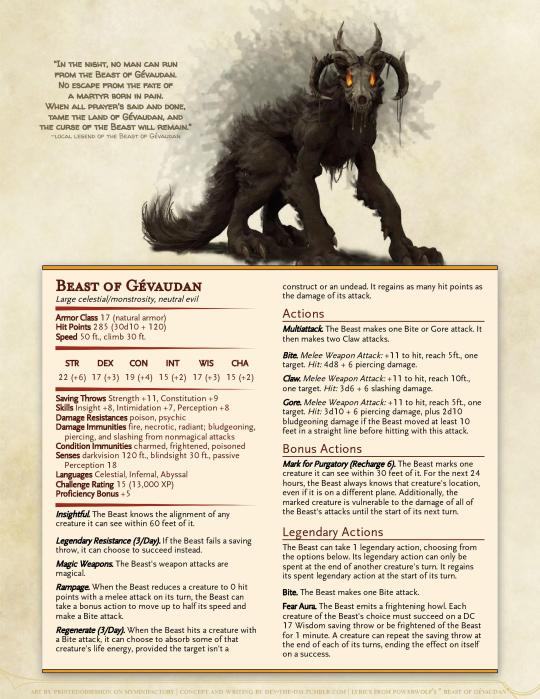
Creature: Beast of Gévaudan
“ Beast of Gévaudan, feared no sword and feared no gun, sent from Heaven, the seventh of creatures. Beast of Gévaudan, for the wrath of God to come, came to sanction the mass and the preachers.
To the father and the son came the Beast of Gévaudan, terminator, a traitor, half wolf, and half machine. To the prior and the nun came the Beast of Gévaudan, a redeemer, believer, all fatal, mad, and mean. “
Divine adjudicator. Some locals from the surrounding areas of Gévaudan believe the Beast to be a creature sent by the gods to root out the persistent corruption in the heart of Gévaudan. Others believe it simply to be a pest upon the lands, preying on farmers and court officials alike. Naturally, it is true that the Beast prowls the land with the most corrupt government - but to conflate the two facts to be one divine fact is madness... right?
Bloodthirst. Those who live their lives in the vicinity of the Beast’s territory are intimately aware of its presence. It often shows itself, if only to cause fear and panic amongst the peasantry, and vanishes as quickly as it appeared. It’s true that it does occasionally attack locals with lower status, but magistrates, dukes and duchesses and attendees of the court have silently but unanimously decided to reduce social appearances everywhere. With no more corrupt counts and scheming queens on the road, the Beast is becoming impatient, and ready to unleash its frenzied eradication methods upon the higher class once again.
Hybrid nature. The Beast has two creature types: celestial and monstrosity. It can be targeted by any effect if it applies to one of its creature types.
Celestial nature. The Beast requires no sleep, food, or drink.
Lyrics from Powerwolf’s “Beast of Gévaudan”, from their album Call of the Wild.
#dnd#d&d#dnd5e#d&d5e#dungeons and dragons#5th edition dungeons and dragons#d&d homebrew#dev's homebrews#creature stat block#celestials#monstrosities#cr15#give the song a listen if you have the time and want to!#i can very much recommend it
358 notes
·
View notes